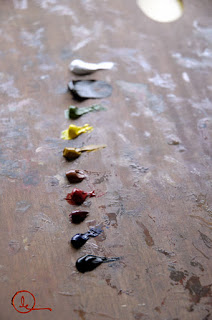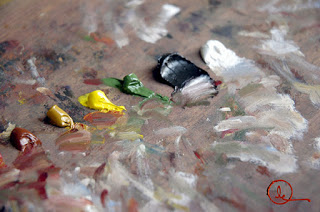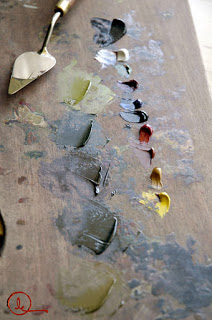To mix, or not to mix . . .
By Elspeth C. Young
 |
| My every-day pigment palette |
When the time came for me to try my hand at my own oil painting, I assumed the same strategy of mix first, paint later. It didn't take me long, however, to discover that I had trouble second-guessing both the color mixes required, as well as the actual amounts of paint needed.
Having begun my artistic sojourn as a watercolor artist, I soon realized that my water-coloring habits of mix-on-the-go would quickly control my oil painting habits as well. Satisfied with my homemade alla prima mixing technique, I decided to pour my paint out on the palette and only "mix" with my brush during the painting process--"wasting" (as I thought at the time) none of the precious creative juices on "needless" premeditated mixing: no time or paint wasted. Or so I thought.
Such a mantra was all well and good for small parts of small paintings, but it wasn't long before I realized that my "seamless" strategy was flawed. While I might not waste much paint during a session of glazing or scumbling details, while painting large surface areas of the panel or color patches of a similar hue, I was wasting all sorts of time endlessly mixing and remixing the same color over and over, minute by minute.
So, such became the dilemma at the outset of each painting session: To Mix, Or Not To Mix? My creative energy seemed to rebel at the idea of having to pre-mix colors, as I had seen my father do. But then again, my artistic conscience knew that from time to time, I was wasting precious time throughout the painting session when I mixed colors as I went, a particle at a time.
 |
| Example of a "mix as you go" palette |
 |
| Example of a "pre-mix" palette |
So the next time you step to your easel, simply assess what you will spend the majority of time painting that day--large areas where paint will be shoveled on with a painting knife, or small intricate glazes softly blended with a breath of brush. Then mix, or don't mix, accordingly.
(Of course, there are yet more alternatives to these two color mixing strategies. During my childhood years, I always saw my father pre-mix his colors, but it has been many years now since he has used that process. Rather than relying on his brush or knife to mix his colors (either before or during each painting session), he now prefers to let his colors mix themselves, one layer at a time. Most of the time, he applies color in stages--each color layer is allowed to dry before he glazes new color over the top--a method which allows for a whole world of colors that, quite literally, could not be mixed beforehand.)
Tags: 2011, Color, Tips and techniques
Browse articles by year: 2026 . 2025 . 2024 . 2023 . 2022 . 2021 . 2020 . 2019 . 2018 . 2017 . 2016 . 2015 . 2014 . 2013 . 2012 . 2011 . 2010 . 2009 . 2008 . 2007 . 2006 . 2005 . 2004 . 2003 . 2002 . 2001 . 2000 . 1999 . 1998 . 1997 . 1996
Browse articles by topic: Art lessons . BenHaven Archives . Blank art diaries . Fine art photography . Framing . Illustration . Inspiration and creativity . Isles of Rune . Limited Editions Collection . My Fathers Captivity . News . Novellas . Oil paintings and prints . Operations announcements . Orders and shipping . Overview . Portfolios . The Papers of Seymore Wainscott . Project commentaries . Recipes by Nancy Young . Recommended reading . Recommended viewing . Temple artworks . The Storybook Home Journal . Tips and techniques . Tools supplies and operations
Browse articles by topic: Art lessons . BenHaven Archives . Blank art diaries . Fine art photography . Framing . Illustration . Inspiration and creativity . Isles of Rune . Limited Editions Collection . My Fathers Captivity . News . Novellas . Oil paintings and prints . Operations announcements . Orders and shipping . Overview . Portfolios . The Papers of Seymore Wainscott . Project commentaries . Recipes by Nancy Young . Recommended reading . Recommended viewing . Temple artworks . The Storybook Home Journal . Tips and techniques . Tools supplies and operations